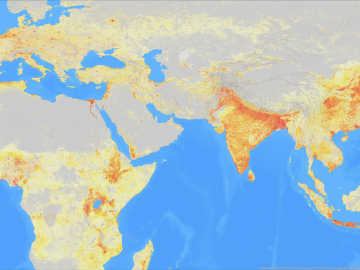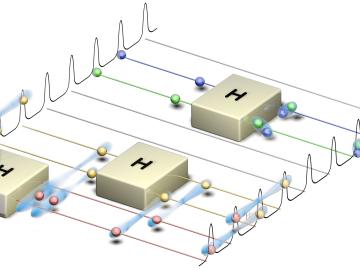Filter News
Area of Research
News Topics
- 3-D Printing/Advanced Manufacturing (1)
- Artificial Intelligence (1)
- Big Data (1)
- Bioenergy (1)
- Biology (2)
- Biomedical (1)
- Computer Science (19)
- Coronavirus (1)
- Cybersecurity (5)
- Energy Storage (1)
- Exascale Computing (2)
- Frontier (4)
- Fusion (1)
- Grid (3)
- High-Performance Computing (6)
- Machine Learning (1)
- Materials (8)
- Materials Science (10)
- Microscopy (2)
- Nanotechnology (7)
- Neutron Science (5)
- Physics (4)
- Quantum Computing (24)
- Quantum Science (45)
- Security (3)
- Simulation (5)
- Summit (2)
Media Contacts

Scientists at Oak Ridge National Laboratory studying quantum communications have discovered a more practical way to share secret messages among three parties, which could ultimately lead to better cybersecurity for the electric grid

Oak Ridge National Laboratory physicists studying quantum sensing, which could impact a wide range of potential applications from airport security scanning to gravitational wave measurements, have outlined in ACS Photonics the dramatic advances in the field.

A team led by scientists at the Department of Energy’s Oak Ridge National Laboratory explored how atomically thin two-dimensional (2D) crystals can grow over 3D objects and how the curvature of those objects can stretch and strain the

OAK RIDGE, Tenn., March 13, 2019 – Two technologies from the Department of Energy’s Oak Ridge National Laboratory have received national Excellence in Technology Transfer awards from the Federal Laboratory Consortium for Technology Transfer: “Qrypt Licensing of Quantum Random Number Generator from ORNL” and “Strategic Licensing of the LandScan/LandCast Population Datasets.”
OAK RIDGE, Tenn., Feb. 12, 2019—A team of researchers from the Department of Energy’s Oak Ridge and Los Alamos National Laboratories has partnered with EPB, a Chattanooga utility and telecommunications company, to demonstrate the effectiveness of metro-scale quantum key distribution (QKD).

Quantum experts from across government and academia descended on Oak Ridge National Laboratory on Wednesday, January 16 for the lab’s first-ever Quantum Networking Symposium. The symposium’s purpose, said organizer and ORNL senior scientist Nick Peters, was to gather quantum an...

Scientists at Oak Ridge National Laboratory and Hypres, a digital superconductor company, have tested a novel cryogenic, or low-temperature, memory cell circuit design that may boost memory storage while using less energy in future exascale and quantum computing applications.

Researchers used neutron scattering at Oak Ridge National Laboratory’s Spallation Neutron Source to investigate bizarre magnetic behavior, believed to be a possible quantum spin liquid rarely found in a three-dimensional material. QSLs are exotic states of matter where magnetism continues to fluctuate at low temperatures instead of “freezing” into aligned north and south poles as with traditional magnets.

By analyzing a pattern formed by the intersection of two beams of light, researchers can capture elusive details regarding the behavior of mysterious phenomena such as gravitational waves. Creating and precisely measuring these interference patterns would not be possible without instruments called interferometers.





